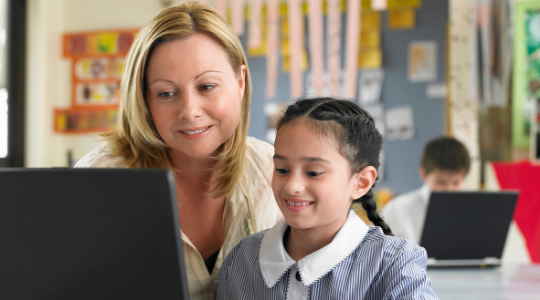
In the International Literacy Association’s 2020 report on “What’s Hot in Literacy” educators from around the world were asked what specific areas they would like more professional development to strengthen their literacy practice. The number one response was “Using digital resources to support literacy instruction”, nominated by almost half of all people surveyed. Using digital resources in general can be daunting, and even more so with literacy which has been so steeped in a tradition of chalk and talk. But there are a few key best practices to follow that can ensure both yourself and your students get the most out of any digital resource you choose.
Teacher presence is key
In The University of Toronto’s paper on Digital Pedagogy, emphasis is placed on the fact that simply having digital tools in the class is not enough to provide students with an effective digital learning experience. In other words, placing students in front of a computer and simply assigning them work is not going to improve their literacy skills. Instead, the teacher needs to be an active participant in the students’ use of the digital resource, through a combination of whole-class instruction, one-to-one tutoring and self-guided learning.
Engaging resources work best
Studies have shown time and again that when students are engaged, they are more likely to retain and be able to demonstrate new information and skills. The exact same goes for digital literacy resources – the more engaging, the more likely students are going to be motivated to use the resource in their own time and see positive results. When a resource is gamified, this effect is further amplified.
Apply success habits
As educators, we know that students do best when they have a growth mindset (Hoskins, 2020). To motivate your students to develop a “can do” approach to literacy learning when using digital resources, encourage students to use the following success habits from the beginning of their learning process:
Give it a go – give every question a try
Finish what you start – keep going as you will get better
Seek help – the feedback, hints and help are there to guide you
Mistakes are OK – you will only get better through trial and error
Challenge yourself – aim to get better with every question
Plan for inclusion
Not all students will have the same access to digital technology, and so it’s important to ensure that students are given the same opportunities to learn through your chosen digital resources. On top of this, not all students will have the same level of prior knowledge when it comes to either digital or standard literacy. Differentiating your lessons where possible is just as important when using a digital resource as it is when planning any other type of lesson.
Develop a learning community
Any type of learning is better when there are a group of people supporting each other – both from an educator and student perspective. Educators should have a place they can go to collaborate with one another, share ideas on how to use the digital resource, manage student progress and develop a shared understanding of how to teach literacy concepts. Students need to feel engaged within the resource itself and find motivation for literacy learning from interacting with their peers. When all parties feel supported by their learning community and the digital resource, literacy learning will be able to truly flourish in the classroom.




